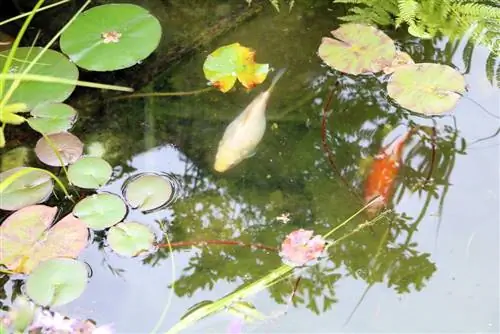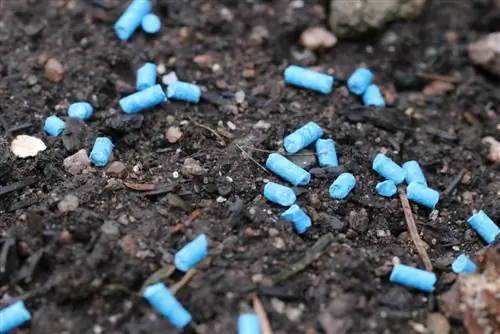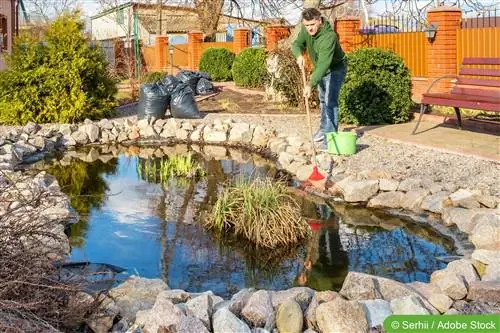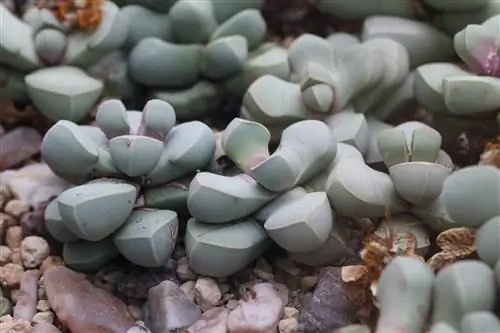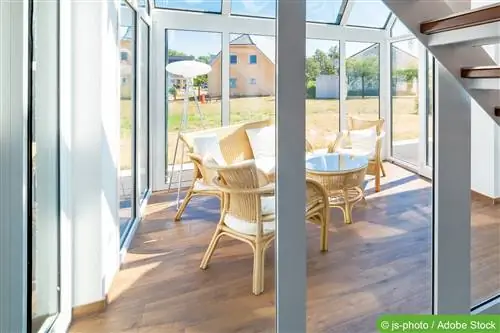- Author admin [email protected].
- Public 2023-12-17 03:39.
- Last modified 2025-06-01 06:48.
Creatures in and around the pond revitalize the water and enrich the biodiversity in the garden. They can be useful themselves but can also provide the nutritional basis for other animals. It's also interesting to follow the hustle and bustle in and around the water - and even educational, especially for children. But which creatures can be found and how do they get into the pond?
Microorganisms
Microorganisms, especially bacteria, are among the first to colonize the garden pond. That's a good thing, because beneficial bacteria ensure the biological balance in the water and break down various substances. Others, however, can cause rot and thus negatively affect the water quality. Therefore, care must be taken to ensure that the organic material in the pond does not become excessive. Dead parts of plants, fallen leaves and also animals that have died in the water must therefore be removed. Otherwise the water can “tip” - i.e. become unbalanced. This is dangerous for the beneficial organisms and the animals in the pond.
Algae
When it comes to typical creatures in the pond, no one thinks of algae first, but they are also part of it and often settle in large numbers, much to the chagrin of pond owners. It is completely natural to find few algae in the water. However, with larger quantities and especially with the so-called blue-green algae, caution is advised and quick action is necessary.
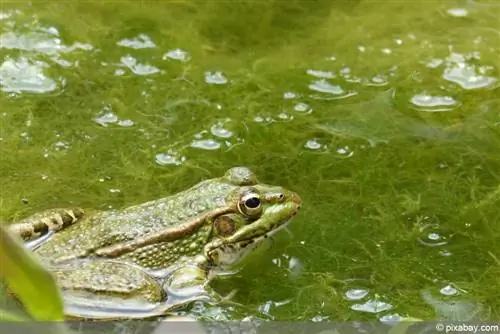
Blue-green algae is a collection of cyanobacteria. Their spread is a sign that there are larger amounts of nutrients in the water. The algae produce additional nutrients themselves and thus disrupt the balance in the pond. If they die and sink to the bottom, the water can tip. Favorable countermeasures are:
- Remove any dirt, such as leaves and plant parts, from the water
- insert a pond filter with UV light
- Remove pond sludge regularly
- Keep fish stocks small
- If necessary, use algae killers that are safe for aquatic life
- use silver carp or grass carp in large ponds
Insects and larvae
As soon as the water is put into the pond, the first insects appear. They fly over the surface of the water and stay on the plants near the pond. Some species use the water to lay eggs, which means that larvae can be seen in the pond within a very short time. Mosquito larvae can be problematic because they often occur in large numbers and are the first sign of a mosquito infestation in the garden.
To prevent this from happening, appropriate countermeasures should be used:
- Introduce fish that feed on the larvae
- Remove larvae from the water with a very fine-mesh quiver
- Attract beneficial insects such as frogs and toads
Of course, not all insects in and around the garden pond are annoying or potentially harmful. The water also attracts dragonflies, water striders and various species of flies. In addition, the pond serves as a source of water for many beneficial insects.
Frogs
Frogs use the garden pond to deposit their spawn and also protect themselves from predators in the water. The croaking is considered annoying by some people and can actually be very persistent and surprisingly loud on some days of the year.
Everyone should accept this small disturbance - because frogs are extremely useful. They feed on insects and thus keep pests at bay. Including, for example, mosquitoes and mosquito larvae.
Toads

The toads also spawn in the pond, but otherwise prefer to stay in the area around the water and not in it. Their diet includes large quantities of insects and their larvae, as well as slugs. Anyone who discovers them in their own garden should be happy about help with pest control.
Newts
Only those who sit quietly by the water for a long time and look closely will be able to spot amphibians every now and then - because the animals are shy and fast. But just like frogs and toads, they are extremely useful. If some specimens are found while cleaning the pond, they should be carefully placed in a bucket and put back into the pond as quickly as possible.
Water snails
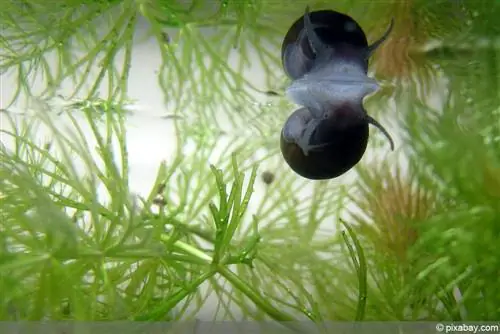
Some pond owners spend a lot of money on water snails from specialist retailers, but the molluscs settle “on their own” if the conditions are right. In some cases they are also introduced via aquatic plants or other animals. Since some species feed on algae, among other things, they can do a good job in the pond and improve the water quality.
Fish
No fish were put into the pond but they suddenly swim through the water? This is rare but possible. For example, when aquatic plants are taken from a pond with fish and there was spawn on them. However, the spawn can also be brought in via other animals, because young fish can still hatch even if the spawn has been wet for several hours out of the water.
Of course, the fish can also be used and for many people they are an essential part of a garden pond. Anyone who chooses these pond inhabitants should pay attention to a few points:
Size of the pond
When you create the pond, it should be clear whether you want to keep fish in it later and which species you should choose. This depends on the water volume required and how deep the garden pond must be for safe wintering.
Claims
Easy-care goldfish or demanding koi? The effort required to keep the fish depends on the requirements of the fish.
Wintering
With the exception of koi, most species of fish can easily overwinter in the garden pond as long as it is deep and large enough and prevents it from freezing over completely.
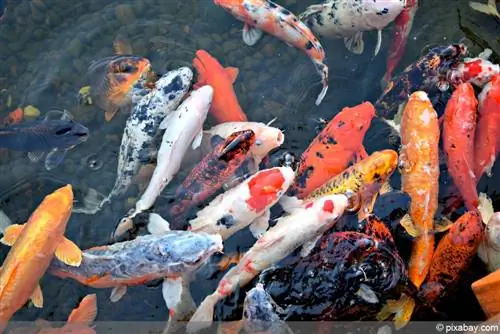
Tolerability
Goldfish are peaceful and can therefore also be socialized with other peaceful species, such as goldfish and grass carp. However, this does not apply to all species and breeding forms. When buying fish, you should therefore seek detailed advice from a specialist retailer.
Shells
Pond mussels are difficult to observe and are often only noticed when the pond is cleaned. Their larvae can be introduced into the garden pond via fish and, more rarely, via plants. The larvae attach themselves to fish and initially live as parasites. When these larvae, the so-called glochidia, develop into adult mussels, they feed on microorganisms and algae, which they filter out of the water. They can also contribute to good water quality.
Birds
For many birds, garden ponds are attractive points and serve as a source of water and food. They catch insects and drink from shallow areas. Larger ponds also occasionally attract ducks, who often go for a swim. But the visit of birds to the garden pond is not always so peaceful and beneficial. Especially if fish have been introduced, a visit from the gray heron or heron is rarely long in coming. The garden pond can also be life-threatening for young birds. The animals in the pond should therefore be protected in the same way as some animals in front of the pond.
Tip:
A heron dummy can keep the danger away from the fish, as it symbolizes to flying animals that the garden pond is already “occupied”.
Attract and protect living creatures
Many microorganisms and animals settle in and around the pond on their own and do not require any special requirements - water and a few plants are already enough for them. But if you want to create ideal conditions for a large number of animal species and also protect them, you should pay attention to a few factors:
Vary water depth
The pond is best laid out in steps so that there are different ledges along the sides. This offers different animal species the right water depth.
Incorporate exit options
Very flat bank areas and stones or slabs stacked stably on top of each other are beneficial for many animal species. Birds and other wild animals can drink more easily here. Animals that have fallen into the pond can save themselves in these places. Shallow bank areas of appropriate size can also serve as birdbaths.

Plant in a variety of ways
Dense swamp plants, water lilies with large floating leaves and aquatic plants offer protection through hiding places, food for many creatures and, in the case of aquatic plants, also oxygen. They serve as a place to lay spawn, can provide shade and also consume nutrients, which in turn benefits water quality. The edge of the pond, shallow bank areas and the pond itself should therefore be planted in a variety of ways. However, the number of plants should not be excessive and should be designed for growth.
Offer hiding places
Densely growing and large-leaved plants already provide hiding places in the water and on the bank, but you shouldn't leave it at that. Stones stacked to form caves, piles of brushwood and leaves, shrubs, hedges and nesting boxes are also welcome. They offer protection, attract various animals and can even be used decoratively for design.
Sun and Shadow
Bright sun all day or only shade is not good for any pond. It is better if at least part of the water surface is slightly shaded. This prevents the water from heating up too much in summer. In addition, the alternation of shady and sunny areas attracts more animal species.
Caution: Nets are dangerous
To protect the pond from fish predators such as cats and herons, nets are occasionally stretched over the water. Unfortunately, these can be fatal for some animals. Birds can become entangled in them while trying to drink or catch insects. The same applies to cats, frogs, toads and many other animals. It is therefore better to offer the pond inhabitants sufficient hiding places and to set up a dummy to ward off herons.

